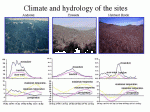For this study, Julia A. Jones, David A. Post of the Andrews LTER site conducted a comparative analysis of forest removal experiments at the Andrews, Coweeta, and Hubbard Brook Experimental Forests.
Multiple paired-basin forest removal experiments have been conducted at each of these sites. We reanalyzed primary data from these LTER sites to understand how climate, forest type, soil moisture or snow storage reservoirs influence hydrologic response to forest harvest experiments. Streamflow responses were examined in nine sets of small treated/control basin pairs that differ in forest type, soils, and snowpacks, but all had 100% forest harvest followed by forest regeneration. Study sites and basin pairs varied in forest type (deciduous forest at CWT and HBR, conifer at AND), snowpack (no snowpack at CWT, transient snow at AND, and seasonal snow at HBR) and soil depth.
We conducted new analyses using original daily streamflow and climate data from each site. We separated baseflow from quickflow because we expected different responses to forest removal from water delivered rapidly vs. slowly to streamflow.
We found that forest canopy removal was associated with a variety of streamflow responses depending upon the site, season, and time period relative to forest harvest. The greater leaf area, longer times since stand establishment, and vegetation physiology at the conifer forest site (AND) may all contribute to its larger, more persistent streamflow response to forest removal compared to the deciduous forest sites. The currently standing conifer forest at the Andrews site was initiated by wildfire about 500 years ago, whereas the deciduous forests (CWT, HBR) were regenerating from early 20th century selective timber harvests and other disturbances (windthrow from hurricanes at Hubbard Brook, chestnut blight at Coweeta) at the time they were cut.
Post-harvest streamflow increases at the conifer site (AND) imply that the old-growth conifer forest was using much more water during fall and spring, when moisture is not limited, than during the dry summers. In contrast, post-harvest streamflow increases at the deciduous sites (CWT, HBR) were confined to the summer and fall, and spring where seasonal snowpacks were present (HBR). Streamflow changes were most persistent at the conifer site (AND), and ephemeral at the deciduous forest sites (CWT, HBR), implying that early successional vegetation and the second growth forests removed at the deciduous forest sites differ little in their water use.
Vegetation species in early succession, which tended to be deciduous or broadleaf in these sites, appear to be higher water users per unit leaf area than the species removed. In contrast, the thirty-year-old regenerating mixed-conifer stands have very different, and much lower, water use than the old-growth forests removed at the conifer forest site (AND). Although changes in forest canopy were brought about by experimental harvest in this study, the streamflow responses are illustrative of vegetation changes that may occur from natural processes, such as wildfire, windthrow, or climate change.
The main finding of this project is that it is possible to predict the magnitude and timing of hydrologic responses to forest removal based on understanding of the principal hydrologic processes at a given site (e.g. evapotranspiration by certain forest types, amount of snow and snowmelt timing, soil depth and texture). Some large changes occurred in streamflow during particular times of year, especially summer and fall and spring. Some of the changes were ephemeral, others were persistent. These findings imply that changes in hydrologic regimes are occurring and have occurred in most systems affected by anthropogenic or climate change.
Next steps include studies to understand the implications of hydrologic responses at various times of year for community dynamics and fluxes of energy and materials.
Datasets at the daily time step were relatively easy to obtain from the three sites (AND, CWT, HBR) although quite a bit of time and some travel was required. Most sites with long-term hydrologic and climate records are not as well prepared as the LTER sites used in this study. Moreover, data are typically not maintained in similar formats or units, so quite a lot of time was spent matching and converting datasets to make them comparable. The ongoing CLIM-DB and HYDRO-DB projects (Fred Swanson, Don Henshaw and Suzanne Remillard), are attempts to develop automated systems for data collection and formatting to overcome these difficulties.
Acknowledgements:
Research supported by NSF grants to Andrews, Coweeta, and Hubbard Brook LTERs and DEB-95-26987 (LTER Intersite Hydrology). Data and comments were provided by: Wayne Swank, Lloyd Swift, and Ned Gardiner (Coweeta); Charlie Cogbill, Jim Hornbeck, Wayne Martin and John Campbell (Hubbard Brook); and Don Henshaw, Suzanne Remillard, and Fred Swanson (Andrews)

 Enlarge this image
Enlarge this image